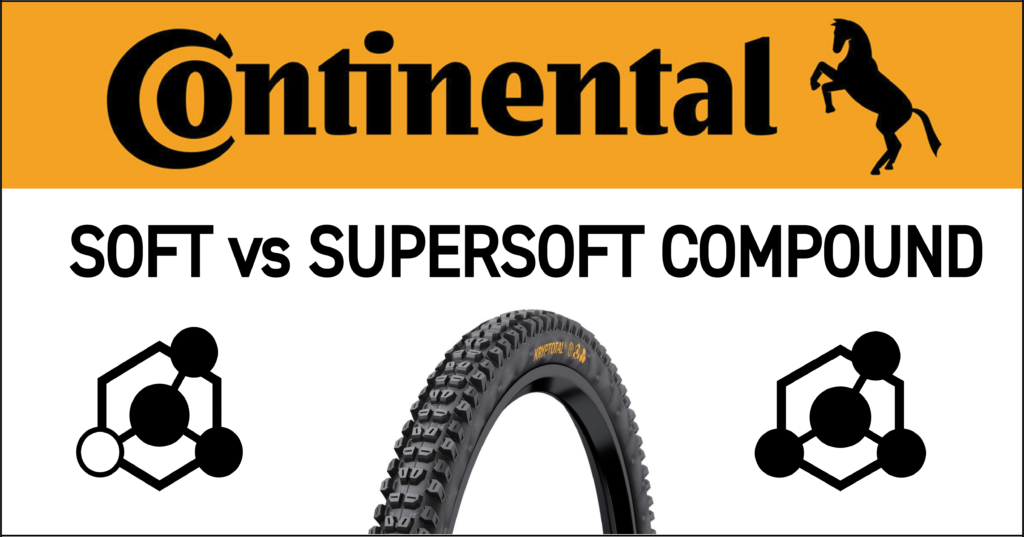Continental Soft vs Supersoft Compound: Continental offers different rubber compounds for their mountain bike tires, with “Soft” and “SuperSoft” being two of the options designed to provide varying levels of grip, durability, and rolling resistance. Here’s a detailed comparison of Continental’s Soft and SuperSoft compounds:
Continental Soft Compound
Features:
- Grip: Provides excellent grip on various terrains, balancing traction with durability. It’s designed to offer a good amount of stickiness without sacrificing too much on rolling resistance.
- Durability: The Soft compound is formulated to offer a reasonable lifespan, making it suitable for a wide range of riding conditions without wearing out too quickly.
- Rolling Resistance: While offering substantial grip, the Soft compound maintains lower rolling resistance compared to the SuperSoft compound, making it more efficient for climbs and flats.
Performance:
- Versatility: Suitable for trail, enduro, and all-mountain riding. It strikes a balance between grip and efficiency, making it a versatile choice for mixed terrain.
- Conditions: Performs well in both wet and dry conditions, providing reliable traction and control.
Continentals Take:
Here is what Continental has to say about their Soft Compound: “The balance of grip and rolling resistance for gravity focussed use cases. High level of grip with a reasonable rolling resistance. Option to optimize the rolling properties of your rear wheel on the DH bike or have the optimal combo for Enduro or Trail riding.” – Continental
Continental SuperSoft Compound
Features:
- Grip: The SuperSoft compound is designed for maximum grip and traction. It offers an extremely sticky and pliable surface that conforms to the terrain, providing unparalleled control, especially on technical and steep descents.
- Durability: Due to its softness and stickiness, the SuperSoft compound wears out faster than the Soft compound. It’s intended for riders who prioritize grip over longevity.
- Rolling Resistance: This compound has higher rolling resistance compared to the Soft compound, making it less efficient for climbing and flat sections but superior in technical, downhill scenarios.
Performance:
- Specialization: Ideal for downhill and aggressive enduro riding where maximum traction and control are crucial. It’s particularly suited for rocky, loose, and technical trails where grip is paramount.
- Conditions: Excels in both wet and dry conditions, but the high grip levels make it especially beneficial in tricky, variable terrain where maintaining control is critical.
Continentals Take:
Here is what Continental has to say about their Supersoft Compound: “Our softest and grippiest compound in the MTB Gravity range. Especially for Downhill and Enduro use cases where the main focus is descending. Tires equipped with this compound are for riders with a 100% focus on grip, traction, control. Recommended for use cases with a large share of descent.” – Continental
Key Differences:
- Grip vs. Rolling Resistance: SuperSoft offers higher grip but also higher rolling resistance compared to Soft. The Soft compound provides a more balanced performance with lower rolling resistance.
- Durability: Soft compound is more durable and better suited for a mix of climbing and descending. SuperSoft wears faster and is best for short, intense downhill runs or technical enduro stages.
- Use Case: Choose SuperSoft for downhill racing or aggressive enduro riding where maximum grip is essential. Opt for Soft for a balance of performance in a wider range of riding conditions.
Recommended Usage:
- Soft Compound: Trail, enduro, all-mountain. Ideal for riders who need a balance between grip and efficiency.
- SuperSoft Compound: Downhill, aggressive enduro. Perfect for riders who prioritize grip and control on technical, steep terrain.
Looking for Continental tires? Shop our full section of Continental tries here. Remember that we offer free shipping on all orders over $149CAD. We process and ship all orders within 24 hours as well.
Spend less and ride the best with TBS Bike Parts.
Related Articles
CONTINENTAL TIRE OVERVIEW: KRYPTOTAL, ARGOTAL, & XYNOTAL
HOW TO CHOOSE THE RIGHT MOUNTAIN BIKE TIRE
CONTINENTAL DH CASING VS. ENDURO CASING
MTB TUBES VS. TUBELESS – ADVANTAGES AND DISADVANTAGES
TIPS & TRICKS FOR INSTALLING TUBELESS MTB TIRES
5 REASONS YOU SHOULD USE TUBELESS MTB INSERTS




